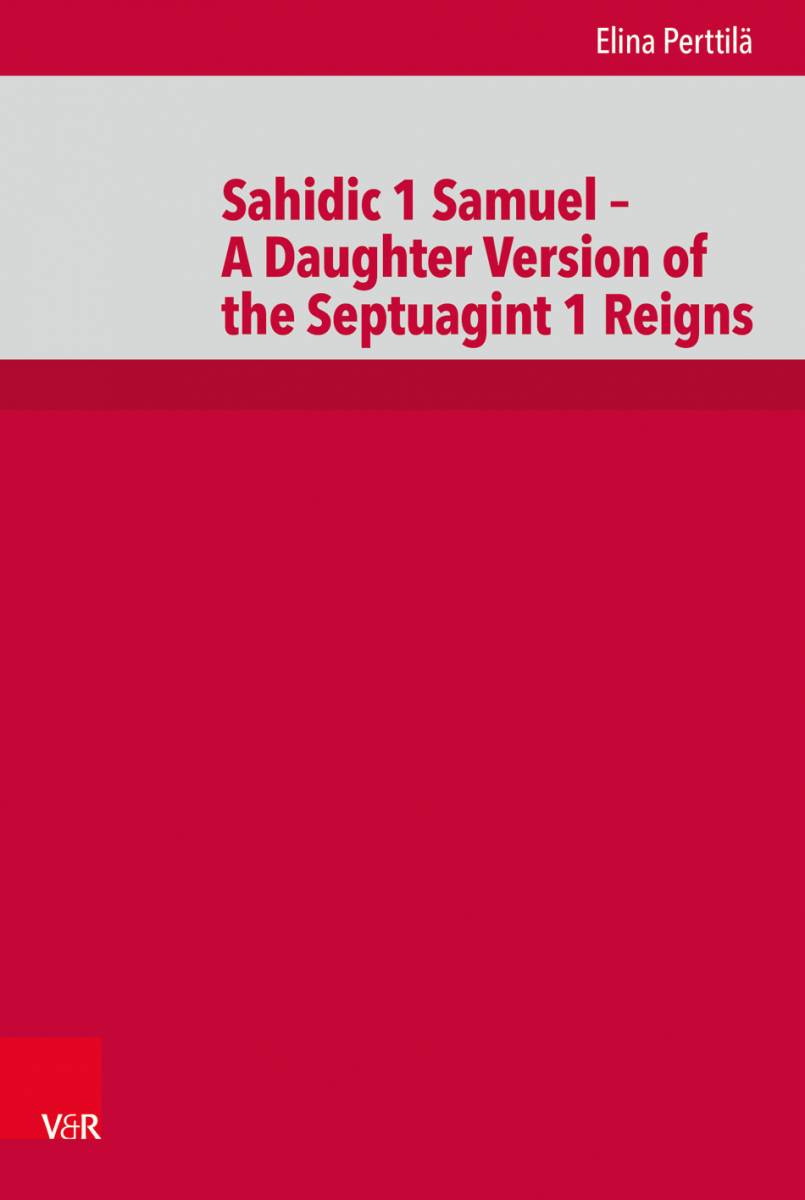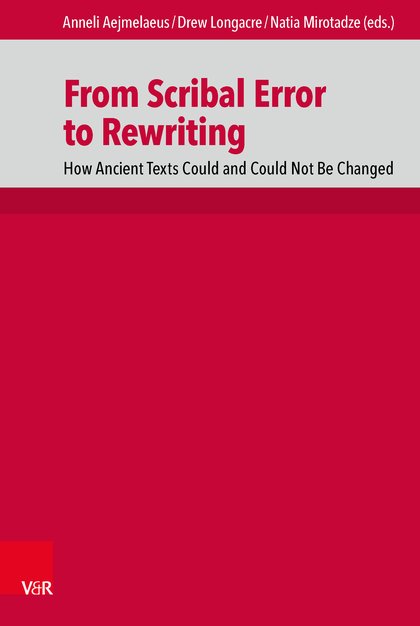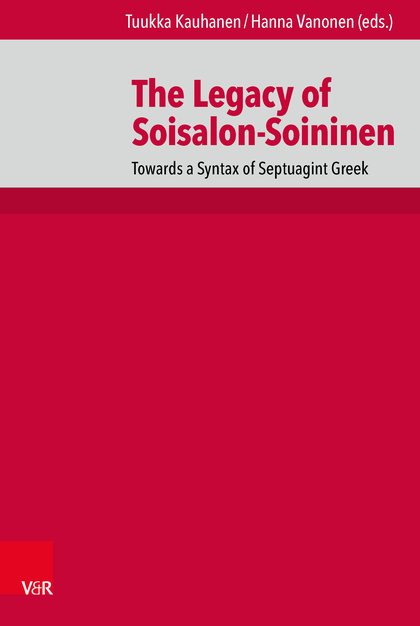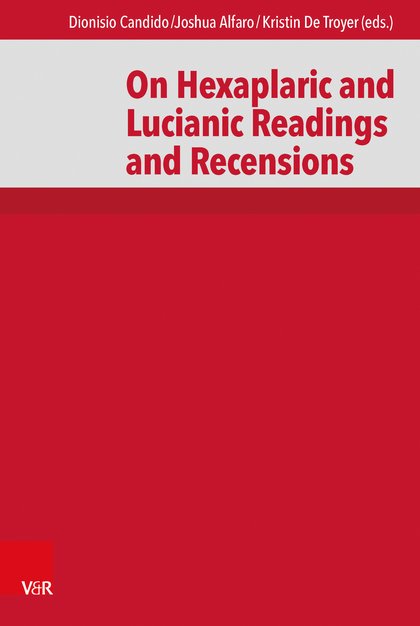De Septuaginta Investigationes (DSI)
Göttingen: Vandenhoeck & Ruprecht, 2011ff.
Die Reihe De Septuaginta Investigationes (DSI) deckt das gesamte Spektrum der internationalen Septuagintaforschung ab. In englischer, deutscher und französischer Sprache erscheinen Monographien und fokussierte Sammelbände, deren Themen von der Septuaginta selbst über die Vorlagen und Tochterübersetzungen bis zur Wirkungsgeschichte reichen. Die Veröffentlichungen sollen den akademischen Diskurs zur Septuaginta und deren Umfeld fördern. Herausgeber: Anneli Aejmelaeus (Universität Helsinki), Felix Albrecht (Akademie der Wissenschaften zu Göttingen), Kristin De Troyer (Universität Salzburg), Wolfgang Kraus (Universität des Saarlandes, Saarbrücken), Michael Segal (Hebräische Universität, Jerusalem). Akademisches Gremium: Kai Brodersen (Universität Erfurt), Cécile Dogniez (Nationales Forschungszentrum, Paris), Peter Gentry (Baptist-Theologisches Seminar, Louisville), Anna Kharanauli (Universität Tbilisi), Armin Lange (Universität Wien), Alison Salvesen (Universität Oxford), Andrew Teeter (Harvard Universität, Cambridge), Julio Trebolle (Universität Madrid), Florian Wilk (Georg-August-Universität Göttingen)

Vol. 1: OLOFSSON, S.: As a Deer Longs for Flowing Streams. A Study of the Septuagint Version of Psalm 42–43 in Its Relation to the Hebrew Text, Göttingen 2011.
This volume of the new DSI series is the most comprehensive investigation of Hebrew and Greek translation equivalents in Ps 42-43 in the Psalter and in the Septuagint as a whole currently available. This detailed study does not only include the translation equivalents in the Septuagint, the semantic meanings of the Hebrew and Greek words are also discussed and parallels in the LXX as well as in the Hebrew Bible are included. A systematic investigation of the translator’s method must be carried out before one can use the manuscripts in a proper way. Accordingly, the extensive translation-technical emphasis and the discussion of text-critical matters make it possible to present a more accurate Old Greek text and this book may thus contribute to a new critical edition of the Greek Psalter. The book is also in some respects in itself a text-critical study, since all variants in Rahlfs’ edition of the Septuagint Psalms, with the addition of Papyrus Bodmer XXIV (Rahlfs 2110), as well as Hebrew variants, are referred to and studied. This includes suggestions and evaluations of the Hebrew Vorlage behind the Septuagint text. It is also a commentary on the Hebrew and the Greek texts of Ps 42-43. Like other commentaries, it describes the position of the psalm, it presents the unity and form of the psalm, its structure and its relation to the close context. As a commentary on both the Hebrew Bible and the Septuagint, it gives an overall interpretation of the psalm in Hebrew and in Greek separately. The book can be read by the specialist in Septuagint studies as well as all scholars interested in translation, textual criticism, and in the book of Psalms, not least its use of metaphors and the reflection of temple theology.

Vol. 2: LAW, T.M.: Origenes Orientalis. The preservation of Origen's Hexapla in the Syrohexapla of 3 Kingdoms, Göttingen 2011.
The Syrohexapla is widely believed to be a faithful witness to the Hexapla of Origen. This Syriac version was produced in the seventh century on the basis of Greek texts related to Origen’s six-columned masterpiece of biblical scholarship. The signs used in Origen’s Hexapla, as well as the readings of several Greek Jewish versions which are no longer fully extant, are preserved in this version. The present study evaluates the Syrohexapla as a witness to these hexaplaric materials in 3 Kingdoms (1 Kings).The nearly 600 signs preserved in the Syrohexapla are analysed, divided into correctly marked asterisks, correctly marked obeli, and inaccurately marked readings. The more than 300 readings attributed to the Greek Jewish versions are treated separately. Finally, by including a chapter which examines a portion of the many readings in the Syrohexapla for which no hexaplaric sign has been preserved, the author balances assessments of the reliability of the Syrohexapla for studying the remains of Origen’s Hexapla.This study prepares the way for the author’s new critical edition of the hexaplaric fragments of 3 Kingdoms.

Vol. 3: KAUHANEN, T.: The Proto-Lucianic Problem in 1 Samuel, Göttingen 2012.
The Lucianic text of the Historical Books is demonstrably a late, recensional text, but it has numerous curious agreements with the earliest witnesses against B and the majority of the manuscripts. Tuukka Kauhanen aims at throwing light on this »proto-Lucianic problem« in 1 Samuel (1 Kingdoms) by taking a comprehensive view of all the relevant witnesses. Kauhanen concludes that there are significantly less of actual proto-Lucianic readings than has often been supposed and refutes the old theory of the »proto-Lucianic recension«.

Vol. 4: KREUZER, S./SIGISMUND, M. (eds.): Der Antiochenische Text der Septuaginta in seiner Bezeugung und seiner Bedeutung, Göttingen 2013. .
The Antiochene or Lucianic text is one of the most important text forms of the Septuagint, the Greek translation of the Old Testament. Its specific form has been understood as the result of the recensional activity of Lucian the martyr (312). Yet, agreements with Josephus, the New Testament, the Old Latin translation, and now especially with the biblical texts from Qumran show that it (also) must be old and close to the original Septuagint. The evaluation of the Antiochene text is of importance not only for the textual history of the Septuagint but also for the description of its original character and because of the relation to its parent text, even for the history of the Hebrew text.This collection of papers presents new insights and actual discussion concerning the history and the importance of the Antiochene Text of the Septuagint.With contributions by Felix Albrecht, Natalio Fernandez Marcos, Philippe Hugo, Jong-Hoon Kim, Thomas Kraus, Siegfried Kreuzer, Martin Meiser, Adrian Schenker, Marcus Sigismund, Victoria Spottorno.

Vol. 5: FINCATI, M.: The Medieval Revision of the Ambrosian Hexateuch. Critical Editing between Septuaginta and Hebraica Veritas in MS Ambrosianus A 147 inf., Göttingen 2016.
At the end of the 11th century the ancient Hexateuch Ms. Ambrosianus A 147 inf. underwent a general restoration: the original majuscule writing was retraced throughout, some lost sheets were replaced, and a great number of variant readings were added, being sometimes preferred to the original text. The purpose of the restoration appears to have been a revision of the Septuagint text in order to make it conform to the Masoretic. Mariachiara Fincati provides a complete analysis of each individual modification by comparing each of them with extant Christian and Jewish Greek translations of the biblical text.

Vol. 6: LESEMANN, S.: „Und Gideon starb in einem guten Greisenalter“. Untersuchungen zu den hebräischen und griechischen Texttraditionen in Ri 6–8 unter Einbeziehung des jüdisch-hellenistischen und frühen rabbinischen Schrifttums, Göttingen 2016.
Das Richterbuch ist eines der textgeschichtlich komplexesten Bücher der Septuaginta. Spätestens im 3./4. Jh. n.Chr. lag es nachweisbar in vier Haupt- und zwei Nebentexttraditionen vor, die sich im Wesentlichen in zwei voneinander zu unterscheidenden Textformen gruppieren lassen. Die Arbeit untersucht die Texttraditionen zum Richterbuch am Beispiel des Gideon-/Jerubbaal-Zyklus Ri. 6,1-8,35 mit dem Ziel, das Verhältnis zwischen prä-masoretischen Vorlagen und proto-masoretischen Konsonantentexten auf der einen und Septuaginta sowie frühen jüdisch-hellenistischen Schriftauslegungen auf der anderen Seite mithilfe von textkritischen, rezeptions- und auslegungsgeschichtlichen Überlegungen näher zu bestimmen. Im Zentrum der Untersuchung stehen dabei die griechischen Textformen von Ri. 6,1-8,35. Der Analyse der griechischen Textformen ist stets eine Synopse der vier rekonstruierten griechischen Haupttexttraditionen nebst masoretischen Text sowie der Angabe von Parallelen in der rabbinischen und parabiblischen Literatur vorangestellt. Von der traditio gilt es auf das traditum, von der Auslegung auf die Vorlage zu schließen und die Pluriformität der griechischen Texttraditionen des Richterbuches zu erklären, mithin deren theologischen Gehalt und Genese darzustellen. Die Ergebnisse dieser Untersuchung lassen u.a. die im Richterbuch alte Frage nach der einen Old Greek in einem neuen Licht scheinen. Darüber hinaus konnten in den verschiedenen griechischen Texttraditionen des Richterbuches Spuren von Theological Exegesis nachgewiesen werden.

Vol. 7: WIRTH, R.: Die Septuaginta der Samuelbücher. Untersucht unter Einbeziehung ihrer Rezensionen, Göttingen 2016. .
Die Dissertation ist ein Beitrag zur Übersetzungs- und Textgeschichte der Samuelbücher. Im Zentrum steht die Arbeitsweise des Septuaginta-Übersetzers. Sie wird anhand von syntaktischen Phänomenen untersucht, die in einer hohen Zahl von Belegen vorkommen. Es ergibt sich ein auch statistisch abgesichertes Bild seiner Übersetzungstechnik, das durch Vergleiche mit anderen Übersetzern der LXX weiter profiliert wird. Wo es das Material ermöglicht, wird die Analyse auf die späteren Rezensionen ausgeweitet. Besonders im Bereich der griechischen Tempora ergeben sich dadurch neue Einsichten in die Rezensionsprinzipien der Kaige-, aber auch der lukianischen Rezension.Die Beobachtungen der Übersetzungs- und Rezensionsweise werfen ein Licht auch auf die Textgeschichte der Samuelbücher. Da es für die Samuelbücher umfassende Funde aus Qumran gibt, kann sie auf Basis einer außergewöhnlich guten Quellenlage rekonstruiert werden. Im Ergebnis wird bestätigt und vertieft, was frühere Untersuchungen gezeigt haben: Die Vorlage der LXX stellt die älteste uns zugängliche Textform dar (2. Jh. v.Chr.). 4QSama steht der LXX nahe, ist jedoch jünger (1. Jh. v.Chr.). Der Masoretische Text repräsentiert deutlich die späteste Stufe der Textentwicklung (1. Jh. n.Chr.). Ein Vergleich der unterschiedlichen Stufen lässt die theologischen Interessen insbesondere der letzten Bearbeitungsstufe (Masoretischer Text) hervortreten.

Vol. 8: PERTTILä, E.: Sahidic 1 Samuel. A Daughter Version of the Septuagint 1 Reigns, Göttingen 2017.
The Sahidic version of 1 Samuel is an ancient daughter version of the Septuagint. Because the Sahidic translation was made before most of the Greek manuscripts we know were copied, it potentially contains ancient readings no longer preserved or only faintly attested in the Greek tradition. This study considers the Sahidic version of 1 Samuel as a translation and how it may best be used in Greek textual criticism. The aim of this study is twofold. First, to examine the translation technique of the Sahidic translator. Second, to analyze the affiliations between the Sahidic manuscripts as well as the affiliations between the Sahidic version and Greek traditions. In the translation-technical section, clause connections and translator s additions feature prominently. In the chapter concerning the affiliations of the Sahidic text, detailed textual analyses prevail. These analyses describe the textual character of each Sahidic manuscript, and search for the existence of secondary readings and/or corruptions. This study supports the creation of a new critical edition of the Septuagint of 1 Samuel for the Göttingen series. With respect to this edition, the primary goal is to identify the affiliations of the Sahidic version. This translation-technical study, however, will additionally allow for a more careful and accurate citation of the Sahidic version within the critical apparatus of the Greek text.

Vol. 9: AEJMELAEUS, A./KAUHANEN, T. (eds.): The Legacy of Barthélemy. 50 Years after Les Devanciers d'Aquila, Göttingen 2017. .
Les Devanciers d’Aquila by Dominique Barthélemy (1963) is an epoch-making work on the textual history of the Septuagint. On the basis of his analysis of the Nahal Hever Minor Prophets Scroll, Barthélemy developed his theory of an early Hebraizing revision (so-called kaige revision), designed to bring the traditional text of the Septuagint closer to the Hebrew text, and recognized examples of it in the B-text of books such as Joshua, Judges, and Samuel-Kings. The work of these early Hebraizing revisers resembled the later very literal translation by Aquila; hence the name of the book, “the predecessors of Aquila”. Textual scholars of today continue in the footsteps of Barthélemy and work on the same questions that were raised in Devanciers: How extensive was the influence of the kaige revision and how can it be recognized? What is the nature of the Lucianic text: when does it represent the Old Greek and when does it give a stylistically revised text? What is the relationship between the kaige revision and Theodotion’s revision of the Septuagint?The present volume mainly consists of papers presented at the 50th anniversary symposium of Les Devanciers d’Aquila that was held in connection with the SBL International Meeting in St Andrews, Scotland, in 2013. The papers focus on history of research, case studies on the text of Samuel-Kings (1–4 Kingdoms), and studies on the text-historical position of specific witnesses.

Vol. 10: POLLNER, M.: Die Vetus-Latina-Fragmente im Jeremiabuch. Untersuchungen zur Textgestalt und deren Lesartendifferenzen gegenüber LXX und MT unter Berücksichtigung inhaltlich-theologischer Bearbeitungsstufen, Göttingen 2018.
Der textkritische Wert der nur in Fragmenten erhaltenen Vetus Latina ist in der Exegese umstritten oder wird kaum wahrgenommen, da die Textzeugen relativ jung sind und häufig keine Einheitlichkeit aufweisen. Innerhalb der überschaubaren Zahl an Vetus-Latina-Fragmenten zum Jeremiabuch weist der Codex Wirceburgensis als ihr quantitativ größter Vertreter gegenüber seinem Quelltext eine erheblich kürzere Textgestalt auf – anders als bei anderen biblischen Büchern. Als Erklärung dienen korrupte Textzeugen oder gar die Annahme, dass die kürzere Textgestalt des Kodex eine gegenüber der Septuaginta prioritäre Textform bewahrt hat. Manfred Pollner widmet sich der Textgestalt dieser Zeugen auf dem Hintergrund der neueren Forschung und überprüft die Lesartendifferenzen gegenüber der alexandrinischen und der masoretischen Textform auf ihren textkritischen Wert. Seine Vorgehensweise ist hierbei geprägt vom Ineinandergreifen verschiedener methodischer Zugänge, wie der diachronen (externen) und der textinternen Betrachtungsweise. Dabei kommt er zu dem Schluss, dass die Vetus Latina-Zeugen des Jeremiabuches global gesehen weder als korrupt eingestuft werden können noch eine gegenüber der Septuaginta prioritäre Textform aufweisen, sondern zum größeren Teil eine innergriechische, zum geringeren Teil auch eine innerlateinische Textentwicklung, in seltenen Füllen sogar prioritäre Lesarten, widerspiegeln. Die Untersuchung enthält im Anhang eine vollständige Synopse der wichtigsten Vetus-Latina-Fragmente zu Jeremia mit MT und LXX.

Vol. 11: DE CROM, D.: LXX Song of Songs and Descriptive Translation Studies, Göttingen 2019.
Dries De Crom intends to stimulate the cross-fertilization of Septuagint Studies and Translation Studies, particularly the theoretical framework of Descriptive Translation Studies (DTS). It engages with concepts and theories from DTS in order to demonstrate their applicability to the study of the Septuagint. The aim is not to replace the established methods of Septuagint Studies, but rather to show that they are fully compatible with descriptive approaches to translation. The greater part of the volume is dedicated to a meticulous verse-by-verse comparison between the LXX and MT texts of Song of Songs. As there is at present no full critical edition of the Greek texts of Song of Songs, due attention is given to the most important witnesses to the pre-Hexaplaric text. The textual study engages with matters of translation technique, textual criticism, linguistic interference and the interpretation of LXX Song of Songs. On the basis of this textual analysis, the volume explores the question of Kaige-Theodotion and LXX Song of Song’s relation to it, as well as the peculiar textual-linguistic profile of LXX Songs of Songs, against the background of translational norms, interference, interlanguage and literary code.

Vol. 12: AEJMELAEUS, A. et al. (eds.): From Scribal Error to Rewriting. How Ancient Texts Could and Could Not Be Changed, Göttingen 2020.
How ancient texts could and could not be changed has been in the focus of vibrant scholarly discussions in recent years. The present volume offers contributions from a representative group of prominent scholars from different backgrounds and specialties in the areas of Classical and Biblical studies who were gathered at an interdisciplinary symposium held in May 2015 at the Ivane Javakhishvili Tbilisi State University in Tbilisi, Georgia. In the first part of the volume Ancient Scribal and Editorial Practices, the authors approach ancient scribal and editorial techniques in Greek, Latin, and Syriac sources concerning classical and biblical texts, their textual criticism, and editorial history. The second part Textual History of the Hebrew Bible focuses on scribal and editorial aspects of the textual history of the Hebrew Bible. The third part Writing and Rewriting in Translation deals with a variety of writings from the Old Testament, New Testament, Apocrypha, and Patristic texts in various languages (Greek, Coptic, Arabic, Armenian, and Georgian), focusing on issues of textual criticism and translation technique. The volume contains an especially rich assortment of contributions by Georgian textual scholars concerning ancient editorial practices and ancient Georgian translations of biblical and patristic texts. This collection of papers provides insights into a variety of different areas of study that seldom come into contact with each other but are clearly in many ways related.

Vol. 13: KAUHANEN, T./VANONEN, H. (eds.): The Legacy of Soisalon-Soininen. Towards a Syntax of Septuagint Greek, Göttingen 2020.
Ilmari Soisalon-Soininen (1917–2002) was a Finnish Septuagint scholar and the father of the translation-technical method in studying the nature of translations. The present volume upholds his work with studies related to the syntax of the Septuagint. It is impossible to describe the syntax of the Septuagint without researching the translation technique employed by the translators of the different biblical books; the characteristics of both the Hebrew and Greek languages need to be taken into consideration. The topics in this volume include translation-technical methodology; case studies concerning the use of the definite article, preverbs, segmentation, the middle voice, and the translations of Hebrew stems in the Pentateuch; selected syntactical features in Isaiah and Jeremiah; the connection between the study of syntax and textual criticism, especially in Judges; and lexical distinction between near-synonymous words. The volume concludes with six articles by Soisalon-Soininen, originally written in German and translated into English. These studies pertain to the use of the genitive absolute, renderings of the Hebrew construct state and the personal pronoun, interchangeability of prepositions, segmentation, and Hebraisms. These articles have lasting value as analyses of significant translation-syntactic phenomena and, together with Soisalon-Soininen’s monographs, they crystallize his translation-technical method. The volume paves way to a description of the syntax of the Septuagint that does justice to its nature as a translation.

Vol. 14: CANDIDO, D. et al. (eds.): On Hexaplaric and Lucianic Readings and Recensions, Göttingen 2021.
In the history of the Greek translation of the Bible, there are two recensions that play a very important role. The first is the Hexaplaric recension of Origen. In this work, Origen displayed the different versions of the Biblical text and aimed at bringing the Greek text as it had been submitted so far closer to the then current Hebrew text. His intervention in the Greek text has "opened the gates to a flood of approximations of the Greek text to the Hebrew" (dixit Anneli Aejmelaeus). Indeed, one can find Hexaplaric readings in many manuscripts, and even in texts, manuscripts and versions that have never been labeled like that. Filtering out what are Hexaplaric readings is of utmost importance to the reconstruction of the Old Greek text, which may then point to another Hebrew text. A similar enterprise was undertaken by Lucian, and his work too needs to be reconstructed and traced in order to establish the Old Greek text. The current volume deals with the books of 1-2 Sam, 1-2 Kings, as well as Joshua and Esther.

Vol. 15: TUCKER, M. (ed.): The Septuagint of Jeremiah. A Study in Translation Technique and Recensions, Göttingen 2022. .
Miika Tucker comprises a translation technical study of the Septuagint version of Jeremiah for the purpose of characterizing the translation. The conclusions draw from different types of changes that occur between chapters 1–28 (Jer a’) and 29–52 (Jer b’). Certain differences between the two reflect the revisional characteristics of the kaige tradition, which suggests that they were produced by a reviser who was invested in a revisionary tradition similar to kaige. Other differences constitute a change toward more natural Greek expression, which is the opposite of what one would expect from a revision since Greek idiom usually does not correspond to the formal characteristics of Hebrew. Such differences are to be understood to reflect a change toward more intuitive use of the Greek language by the first translator. Changes toward less formal equivalence of the Hebrew and the growth of the Hebrew text after the initial translation combined to form conducive conditions for revision.

Vol. 16: ALBRECHT, F./FEDER, F. (eds.): Editing the Septuagint. The Unfinished Task. Papers presented at the 50th anniversary of the International Organization for Septuagint and Cognate Studies, Denver 2018, Göttingen 2022.
The Greek Old Testament, commonly known as Septuagint, has its origins in Ptolemaic Egypt. Egypt developed into a strongly bilingual country, and in the fourth century CE, when Christianity was on firmer ground in Egypt, the Septuagint was translated into Coptic. The intertwined and prolific relation between the Greek and the Coptic Old Testament is now aptly reflected also in the joint ventures of the Göttingen Academy of Sciences and Humanities. Since the 19th century, Göttingen was and is the global center of Septuagint research. In 2015, a new Academy project started, which deals with the translation of the Septuagint into Coptic-Sahidic: “Digitale Gesamtedition und Übersetzung des koptisch-sahidischen Alten Testaments”. Finally, in 2020, the new long-term project “Die Editio critica maior des griechischen Psalters” started at the Göttingen Academy. Both projects work closely together, and the present volume is one of the results of this fruitful collaboration.

Vol. 17: GENTRY, P.J.: Text History of the Greek Ecclesiastes. Introduction to the Göttingen Septuagint Edition of Ecclesiastes), Göttingen 2022.
Peter J. Gentry provides a complete and full introduction to the critical edition of Ecclesiastes in the Göttingen Septuaginta series along with user-friendly explanations for non-specialists as well as detailed documentation to demonstrate the basis for the critical text of Greek Ecclesiastes. Text History volumes supporting the critical editions in the Göttingen Septuaginta usually provide evidence and lists to document and demonstrate the recensions existing in the textual history and the best methodology for arriving at the earliest form of the text that we can reach. Gentry’s Text History volume provides, in addition, a complete and full introduction which was not given in the critical edition. Since this introduction is in English, it will aid English-speaking scholars who find access to the critical editions difficult because the introductions are in German.

Vol. 18: ALBRECHT, F./KRATZ, R.G. (eds.): Editing the Greek Psalter, Göttingen 2024. OPEN ACCES.
This collected volume is an indispensable part of any theological and philological library. It provides a detailed and up-to-date overview of the Greek Psalter, which plays a central role in the study of the Septuagint. Featuring contributions from leading experts in a variety of disciplines, this work covers all relevant aspects of the Greek Psalter. From text-critical analyses to linguistic and historical considerations, this volume offers profound insights, making it an essential resource for researchers and academics in Biblical Studies and related disciplines. With contributions by Anneli Aejmelaeus, Felix Albrecht, Luciano Bossina, Ralph Brucker, Roberto Carrera, Claude Cox, Stephen Delamarter, Lina Elhage-Mensching, Frank Feder, Stig Frøyshov, Anna Kharanauli, Reinhard G. Kratz, Siegfried Kreuzer, John Lee, Margherita Matera, Martin Meiser, Ugo Mondini, Reinhard Müller, Curt Niccum, Dimitrios Papanikolaou, Georgi Parpulov, Willem Th. van Peursen, Alison Salvesen, Eva Schulz-Flügel, Michael Segal, Stefano Serventi, Maria Tomadaki, Emanuel Tov, Ronny Vollandt and Martin Wallraff.

Vol. 19: MEADE, J.D. (ed.): The Forerunners and Heirs of Origen’s Hexapla, Göttingen 2024. OPEN ACCES.
Although Origen and his Hexapla are well known among biblical scholars, questions about his philology, particularly textual criticism, persist. The Hexapla contained very important texts and translations of the Hebrew Scriptures, but unfortunately it was probably destroyed in the seventh century and we possess only fragments of it. This volume systematically treats the questions of Origen’s forerunners and heirs and attempts to reconstruct how Origen developed the philological method he received and also how his followers received and innovated his textual work.